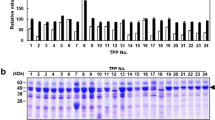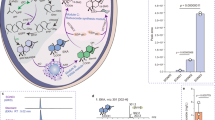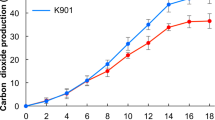Abstract
We describe the heterologous expression of monellin in the yeast Candida utilis. A single-chain monellin gene was expressed under the control of the glyceraldehyde-3-phosphate decarboxylase gene promoter from C. utilis. A promoter-deficient marker gene allowed high-copy-number integration of vectors into either the rDNA locus or the URA3 gene locus. Monellin was produced at a high level, accounting for >50% of the soluble protein. No significant decrease in the production level of monellin was detected in transformants after 50 generations of nonselective growth.
This is a preview of subscription content, access via your institution
Access options
Subscribe to this journal
Receive 12 print issues and online access
$209.00 per year
only $17.42 per issue
Buy this article
- Purchase on Springer Link
- Instant access to full article PDF
Prices may be subject to local taxes which are calculated during checkout
Similar content being viewed by others
References
Buckholz, R.G. and Gleeson, A.G. 1991. Yeast systems for the commercial production of heterologous proteins. Bio/Technology 9: 1067–1072.
Cregg, J.M., Vedvick, T.S. and Raschke, W.C. 1993. Recent advances in the expression of foreign genes in Pichia pastoris. Bio/Technology 11: 905–910.
Ichii, T. et al. 1993. Development of a new commercial-scale airlift fermetor for rapid growth of yeast. J. Ferment. Bioeng. 75: 375–379.
Boze, H., Moulin, G. and Galzy, P. 1992. Production of food and fodder yeasts. Crit Review Biotech. 12 65–86.
Kondo, K., Saito, T., Kajiwara, S., Takagi, M. and Misawa, N. 1995. A transformation system for the yeast Candida utilis: use of a modified endogenous ribo-somal protein gene as a drug-resistant marker and ribosomal DMA as an integration target for vector DMA. J. Bacteriol. 177: 7171–7177.
Morris, J.A. and Cagan, R.H. 1972. Purification of monellin, the sweet principle of Discorephyllum cumminisii. Biochem. Biophys. Acta. 261: 114–122.
Bohak, Z. and Li, S.-L. 1976. The structure of monellin and its relation to the sweetness of the protein. Biocim. Biophys. Acta. 427: 153–170.
Kohmura, M., Nio, N. and Ariyoshi, Y. 1990. Complete amino acid sequence of the sweet protein monellin. Agric. Biol. Chem. 54: 2219–2224.
Kim, S.-H. et al. 1989. Redesigning a sweet protein: increased stability and renat-urability. Protein Eng. 2: 571–575.
Lee, J.H. et al. 1988. Expression of synthetic thaumatin genes in yeast. Biochemistry 27: 5101–5107.
Zemanek, E.G. and Wasserman, B.R. 1995. Issues and advances in the use of transgenic organisms for the production of thaumatin, the intensely sweet protein from Thaumatococcus danielli. Critical Reviews in Food and Nutrition 35: 455–466.
Penarrubia, L., Kim, R., Giovannoni, J., Kim, S.-H., and Fischer, R.L. 1992. Production of the sweet protein monellin in transgenic plant. Bio/Technology 10: 561–564.
Lopes, A.S. et al. 1989. High-copy-number integration into the ribosomal DMA of Saccharomyces cerevisiae: a new vector for high level expression. Gene 79: 199–206.
Lopes, T.S., Hakkaart, G.-J.A.J., Koerts, B.L., A., R.H., and Planta, R.J. 1991. Mechanism of high-copy-number integration of pMIRY-type vector into ribosomal DMA of Sccharomyces cerevisiae. Gene 105 83–90.
Lopes, T.S., De Wijs, I.J., Steenhauer, S.I., Verbakel, J. and Planta, R.J. 1996. Factors affecting the mitotic stability of high-copy-number integration into ribosomal DMA of Saccharomyces cerevisiae. Yeast 12: 467–477.
Sambrook, J., Fritsch, E.F. and Maniatis, T. 1989. Molecular cloning: a laboratory manual, 2nd ed. Cold Spring Harbor Laboratory Press, Cold Spring Harbor, NY.
Hartley, J.L. and Donelson, J.E. 1980. Nucleotide sequence of the yeast plasmid. Nature 286: 860–864.
Struhl, K., Stinchcomb, D.T., Scherer, S. and Davis, R.W. 1979. High-frequency transformation of yeast: autonomous replication of hybrid DNA molecules. Proc. Nail. Acad. Sci. USA 76: 1035–1039.
Yamano, S., Tanaka, J. and Inoue, T. 1994. Cloning and expression of the gene encoding a-acetate decarboxylase from Acetobacter aceti ssp. xylinum in brewer's yeast. J. Biotechnol. 32: 165–171.
Kondo, K. and Inouye, M. 1991. TIP1, a cold-shock inducible gene of Saccharomyces cerevisiae. J. Biol. Chem. 266: 17537–17544.
Author information
Authors and Affiliations
Rights and permissions
About this article
Cite this article
Kondo, K., Miura, Y., Sone, H. et al. High-level expression of a sweet protein, monellin, in the food yeast Candida utilis. Nat Biotechnol 15, 453–457 (1997). https://doi.org/10.1038/nbt0597-453
Received:
Accepted:
Issue Date:
DOI: https://doi.org/10.1038/nbt0597-453



